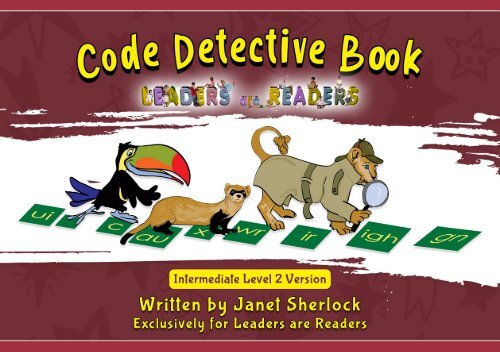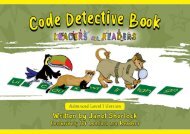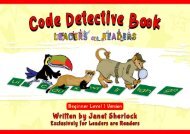Code Detective Book T2 Level 2
Create successful ePaper yourself
Turn your PDF publications into a flip-book with our unique Google optimized e-Paper software.
Written by Janet Sherlock exclusively for Leaders are Readers.<br />
Written by Janet Sherlock exclusively<br />
for Leaders are Readers<br />
Dedicated to the memory of Roger Sherlock,<br />
a devoted father and husband.<br />
Intermediate <strong>Level</strong> 2<br />
Please refer to the week’s Homework Timetable for the pages appropriate for<br />
your child’s current level of knowledge.<br />
For use only by a child enrolled on the Leaders are Readers programme.<br />
The lending or selling on or imitation of this book is prohibited.<br />
Do not photocopy or reproduce in any form.<br />
Legal action will be considered if these terms are contravened.<br />
© Leaders are Readers & Janet Sherlock
Please stick in box below a photograph of your child or cut out and<br />
stick a picture of a person, animal or object from an old magazine.<br />
Then read out the following to your child. Please use your own words if you prefer.<br />
Here is a picture.<br />
Who (or what)<br />
does it represent?<br />
Just like this picture represents you [or name the person, object<br />
or animal], letters are pictures representing the sounds we<br />
speak. Letters are pictures of sounds - they are sound pictures.<br />
i
Read out the following to your child. Please use your own words if you prefer.<br />
Letters are pictures representing the sounds we speak. Letters<br />
are pictures of sounds - they are sound pictures.<br />
Here is a picture for a sound.<br />
<strong>Code</strong> <strong>Detective</strong>: Do<br />
you know the sound<br />
this picture represents?<br />
If you do, shout it<br />
out loud!<br />
C<br />
<strong>Code</strong> <strong>Detective</strong>: Look at the sound pictures in this book. Can you work out<br />
which sounds they represent?<br />
ii
c a t<br />
1
ck<br />
ck<br />
ck<br />
2
t a p<br />
3
Tip-top!<br />
4
f a t<br />
5
ff<br />
ff<br />
ff<br />
6
s a t<br />
7
ss<br />
ss<br />
ou se se<br />
8
C(e)<br />
C(i)<br />
C(y)<br />
ce<br />
ce<br />
9
Good work!<br />
10
m o p<br />
11
mm<br />
mm<br />
er<br />
mm<br />
12
t o p<br />
13
tt<br />
tt<br />
tt<br />
14
c o t<br />
15
tch<br />
(w)a<br />
qu<br />
(qu)a<br />
qu<br />
sh<br />
16
p o t<br />
p o p<br />
17
pp<br />
pp<br />
pp<br />
18
a g<br />
19
gg<br />
gg<br />
le<br />
le<br />
gg<br />
20
u g<br />
21
Exactly right!<br />
22
p i n<br />
23
th<br />
dd<br />
24
a t<br />
25
bb<br />
er<br />
ed<br />
bb<br />
26
j u g<br />
27
Thumbs up!<br />
28
d i g<br />
29
dd<br />
dd<br />
le<br />
er<br />
dd<br />
30
a t<br />
31
rr<br />
rr<br />
wr<br />
wr<br />
wr<br />
rh th rh<br />
32
h a t<br />
33
That's awesome!<br />
34
w e b<br />
35
wh<br />
wh<br />
wh<br />
36
z i p<br />
wh<br />
37
zz<br />
zz<br />
ze<br />
ze<br />
se<br />
38
e<br />
gg<br />
39
Top-notch!<br />
40
m a n<br />
41
nn<br />
nn<br />
er<br />
nn<br />
kn<br />
kn<br />
ee<br />
kn<br />
gn<br />
gn<br />
gn<br />
42
v a n<br />
43
er<br />
ve<br />
ve<br />
ve<br />
44
l i p s<br />
ck<br />
45
ll<br />
ll<br />
ll<br />
pp<br />
le<br />
le<br />
le<br />
el<br />
el<br />
el<br />
46
f o x<br />
47
Hats off!<br />
48
Talk to your child as follows. Please use your own words if you prefer.<br />
What is this?<br />
1<br />
But this is?<br />
12<br />
What is this?<br />
2<br />
What is this?<br />
t<br />
But this is?<br />
th<br />
What is this?<br />
h<br />
Some sounds are represented with one letter and others are represented<br />
with two or more letters.<br />
49
Read out the following to your child. Please use your own words if you prefer.<br />
<strong>Code</strong> <strong>Detective</strong>: can you spot the sounds<br />
on the next four pages which<br />
are represented by two letters?<br />
Which sounds are they?<br />
Show all the different sounds on a piece of paper.<br />
Then see if your Mum or Dad knows the answer!<br />
50
qu ee n<br />
qu<br />
ck<br />
qu<br />
qu<br />
51
th i n<br />
th ck th<br />
th<br />
52
f ea th er<br />
th<br />
th<br />
th<br />
53
f i sh<br />
sh<br />
sh<br />
sh<br />
54
Please read out the following to your child. Use your own words if you prefer.<br />
Look at these two different pictures.<br />
What does this picture<br />
represent?<br />
What does this different<br />
picture represent?<br />
Child would expectedly say each time, ‘A cat!’<br />
So you see, two different pictures can represent the same thing.<br />
The sound picture below<br />
represents ‘ch’.<br />
ch<br />
This different sound picture<br />
also represents ‘ch’.<br />
tch<br />
Sometimes different sound pictures represent the same sound.<br />
55
Read out the following to your child. Please use your own words if you prefer.<br />
<strong>Code</strong> <strong>Detective</strong>: can you spot the different sound pictures<br />
on the next page which all show the same sound?<br />
Which sound is it?<br />
How many ways can the sound be shown?<br />
Show all the different ways on a piece of paper.<br />
Then see if your Mum or Dad knows the answer!<br />
56
ch i ck<br />
ch<br />
ch<br />
ch<br />
57
tch<br />
tch<br />
tch<br />
58
oa t<br />
oa<br />
oa<br />
oa<br />
ow<br />
ow<br />
ow<br />
59
oe<br />
oe<br />
oe<br />
o<br />
o<br />
e<br />
e<br />
o-e<br />
60
ough<br />
ough<br />
ough<br />
61
Read out the following to your child. Please use your own words if you prefer.<br />
The sound pictures in the left column represent different sounds. Each sound<br />
picture has an “e” [egg] in it. The sound pictures can be cut in some words.<br />
When the sound picture is cut, you have to hop-over the sound in the middle<br />
to complete reading the sound picture, before you read the sound in the middle.<br />
ae<br />
ee<br />
ie<br />
oe<br />
ue<br />
62
a<br />
a<br />
e<br />
e<br />
a-e<br />
e<br />
e<br />
e<br />
e<br />
e-e<br />
e<br />
e<br />
i-e<br />
63
o<br />
o<br />
e<br />
e<br />
o-e<br />
u<br />
u<br />
e<br />
e<br />
u-e<br />
64
c<br />
ow<br />
ow<br />
ow<br />
ow<br />
ou<br />
ou<br />
ou<br />
65
ough<br />
t<br />
ough<br />
l<br />
ough<br />
66
g ir l<br />
sh<br />
ir<br />
ir<br />
ir<br />
er<br />
er<br />
er<br />
67
ur<br />
ur<br />
ur<br />
ear<br />
ear<br />
ear<br />
or<br />
re<br />
(w)or<br />
re<br />
68
f ee t<br />
ee<br />
ee<br />
ee<br />
ea<br />
ea<br />
ea<br />
69
ey<br />
ey<br />
sh<br />
ie<br />
ie<br />
ie<br />
e e e-e<br />
70
Revision<br />
71
Read out the following to your child. Please use your own words if you prefer.<br />
These two pictures are the same.<br />
Here, it is a lollipop.<br />
But here, it is a balloon.<br />
This is a sound picture<br />
for ‘oe’, like in ‘flow’.<br />
ow<br />
But here it represents<br />
‘ow’, like in ‘brown’.<br />
ow<br />
Sometimes the same sound picture can represent different sounds.<br />
72
Read out the following to your child. Please use your own words if you prefer.<br />
<strong>Code</strong> <strong>Detective</strong>: can you spot a sound picture on the next<br />
pages that is also the sound picture for a different sound?<br />
Which different sounds does the sound picture represent?<br />
Can you show on a piece of paper one word for each different<br />
sound?<br />
Then see if your Mum or Dad knows the answer!<br />
73
Which different sounds does this sound picture represent?<br />
ow<br />
74
c l ow n<br />
ow<br />
ow<br />
ow<br />
ow<br />
ow<br />
75
This sound picture represents more than one sound.<br />
Which different sounds does the sound picture represent?<br />
o<br />
76
ll<br />
77
<strong>Detective</strong>, have you detected that when there is le at the end of a word,<br />
you may have to read a, e, i, o, u as ae, ee, ie, oe, ue? And have you<br />
discovered that you may only do this when there is no more than one<br />
sound between the a and the le, the e and the le, and so on.<br />
ae a le<br />
ee e le<br />
ie i le<br />
oe o le<br />
ue u le<br />
78
t a b le<br />
a (-le)<br />
k e b le<br />
t i t le<br />
e (-le)<br />
i (-le)<br />
n o b le<br />
o (-le)<br />
b<br />
u<br />
g<br />
le<br />
u (-le)<br />
79
<strong>Detective</strong>, you are amazing! So clever!<br />
80





